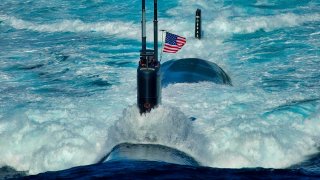Dynamic Manta 24: Inside NATO's Largest Anti-Submarine Wargame Ever
Exercise Dynamic Manta 24, NATO's largest anti-submarine warfare exercise, underscores the critical importance of submarines and anti-submarine tactics in modern naval warfare.
Summary: Dynamic Manta 24, NATO's largest anti-submarine warfare exercise, underscores the critical importance of submarines and anti-submarine tactics in modern naval warfare. Conducted in the Mediterranean Sea, this exercise involved warships, aircraft, and submarines from seven NATO countries, including Canada, Greece, Germany, Italy, the United Kingdom, Turkey, and the U.S. Participants alternated roles between hunter and prey, sharpening their skills in both submarine operations and anti-submarine warfare, aiming to enhance interoperability and teamwork.
Submarines at the Forefront: NATO's Largest Anti-Submarine Warfare Driill
Submarines are probably the most dangerous warships. Through stealth and skill, a single small sub can even take out an aircraft carrier.
Harnessing the power of submarines is an important but difficult vocation, as is mastering anti-submarine warfare. As with most things in life, practice makes perfect. During a recent exercise in the Mediterranean Sea, dozens of NATO warships and thousands of sailors simulated submarine warfare.
Hunting the Hunters
During Exercise Dynamic Manta 24, surface combatants and submarines from across NATO pitted their abilities against one another.
“Anti-Submarine Warfare is a team sport, with each platform bringing its unique capability and valuable contribution, and these exercises enable our Allies and teams to sharpen their skills as well as work on new tactics while enhancing interoperability and teamwork,” Commander, Submarines NATO U.S. Navy Rear Adm. Thomas Wall said in a press release.
This is NATO’s largest anti-submarine warfare exercise. Dynamic Manta 24 ran from the middle of February to early March and included warships and aircraft from seven NATO countries: Canada, Greece, Germany, Italy, the United Kingdom, Turkey, and the U.S. Warships, aircraft, and submarines alternated between the roles of “hunter” and “prey,” allowing personnel to hone their craft both in submarine operations and anti-submarine warfare.
According to NATO, the goal of the exercise was to present the participants with complex and challenging anti-submarine warfare training, not only perfecting their skills, but also increasing their interoperability.
“Developing our collective skills in anti-surface warfare contributes directly to the NATO Deter and Defense concept by improving our ability to ensure a comprehensive maritime situation awareness from sea-bed to space,” Wall added.
Submarine Warfare and China
Submarines have almost strangled whole nations out of a war. German submarines, for example, sank so many ships that were heading to the United Kingdom with provisions during World War One and World War Two that British governments considered negotiations.
Today, submarines remain as deadly as ever.
Large-scale naval warfighting has not occurred in quite some time, and the latest wartime sinking of a warship by a submarine took place during the Falklands War in 1982. But realistic NATO exercises are showing that a submarine can still sink any warship. For example, in 2005, a small Swedish submarine managed to land several torpedo “hits” against the USS Ronald Reagan aircraft carrier during an anti-submarine warfare exercise off the coast of California. In 2013, the USS Dallas, a Los-Angeles-class attack submarine, managed several training “hits” against the British aircraft carrier HMS Illustrious.
In a potential conflict with China in the Indo-Pacific, submarines would play an important role in containing the Chinese Navy, which is the largest in the world with over 700 warships and support vessels. Beijing’s anti-access/area denial capabilities must also be considered, as these could prevent U.S. and NATO warships from approaching Taiwan. Submarines would then be even more important for attacking China’s landing fleet.
About the Author
Stavros Atlamazoglou is a seasoned defense and national security journalist specializing in special operations. A Hellenic Army veteran (national service with the 575th Marine Battalion and Army HQ), he holds a BA from the Johns Hopkins University, an MA from the Johns Hopkins’ School of Advanced International Studies (SAIS). He is pursuing a J.D. at Boston College Law School. His work has been featured in Business Insider, Sandboxx, and SOFREP.


